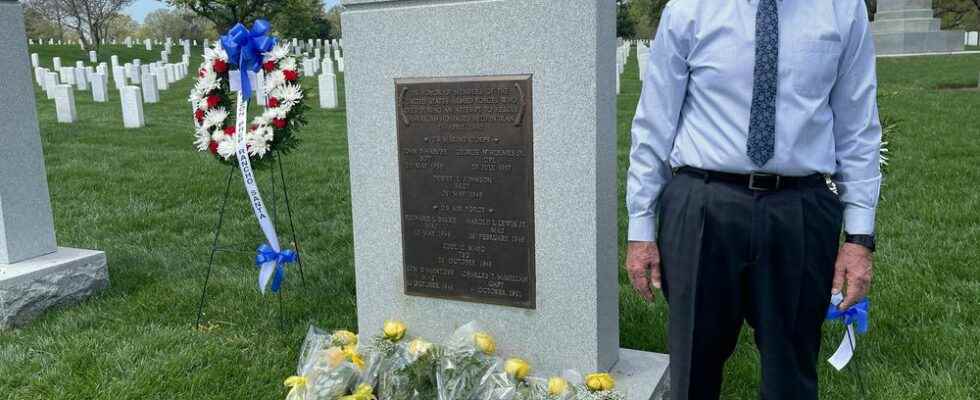Like every spring, on April 24, they come to honor the memory of their eight brothers in arms who disappeared in the Iranian desert during the failed attempt to free American hostages in 1980. On that day, around fifty “veterans” were present for the 32nd time at the Arlington Military Cemetery, where John F. Kennedy is buried.
A ten-minute walk from the tomb of the president assassinated in 1963, we discover, among an ocean of white crosses, the memorial of the astronauts of the Challenger shuttle (exploded in flight in 1986). And, right next to it: the stele dedicated to Operation Eagle Claw. A fiasco remembered as the summary of Democrat Jimmy Carter’s failed mandate, marked by inflation and the economic slump.
At the time, it had been several months since more than fifty American diplomats had been held hostage by fanatical Islamic revolutionaries. Begun in November 1979, their detention in Tehran will last 444 days until January 1981. In the meantime, the president has launched the daring and top-secret special operation which he hopes will free his compatriots. In addition to two C-130 troop transport planes, eight helicopters are mobilized.
Mission: fly over Iran at low altitude, land in the desert, establish a base camp, take off again towards Tehran, free the hostages. Alas, the operation aborts on the base camp because the aircraft are surprised by a sandstorm which prevents any visibility. In the fog, a helicopter turns back. A second has a breakdown. A third, during an ordinary manoeuvre, hit a C-130 on the ground and caught fire at the base camp. The whole operation is compromised. All you have to do is go home empty-handed. It is humiliation. Ayatollah Khomeini talks about divine justice. Seven months later, Carter was beaten soundly by Ronald Reagan.
Thom Beres was a flight engineer on a C-130 during the failed rescue of American hostages in Iran in 1980
Axel Gylden
Good. But what does this have to do with the war in Ukraine today? To this question, the “veterans” of Operation Eagle Claw, all in their sixties or seventies, have an answer. “Remember that after the annexation of Crimea by Russia in 2014, American special forces began to train Ukrainian special forces,” explains Thom Beres, a C-130 flight engineer who, during the fatal April 24 , saw through his window a friendly helicopter crash, causing eight deaths. However, it was from the failure in Iran that all the training of American special forces was redesigned.
The Yankee fiasco can indeed be explained by the lack of coordination and radio communication, by the disparity between the teams (some soldiers came from the Navy, others from the US Air Force, still others from the Marine Corps), by the use of sometimes different equipment depending on the aircraft and, all, following an unclear chain of command. “Two senior officers each believed to be the real commanders of the operation,” reads a declassified investigation report.
A photo distributed on February 21, 2022 by the press service of the Ukrainian army general staff shows Ukrainian soldiers training at an unspecified location.
afp.com/STR
After the fiasco of 1980, the army, still impregnated with the “Vietnam mentality”, puts all its mistakes to rest and completely rethinks its way of waging war. In 1986, the Goldwater-Nichols Act was the prelude to the complete reorganization of the American chain of command and the creation of the first special forces units the following year. “It was a question of emphasizing the flexibility and the freedom of initiative of the troops on the ground, explains a helicopter pilot present at the cemetery of Arlington. Which is the exact opposite of the way of functioning of the Russian army in Ukraine. This is hampered by a rigid chain of command which prevents the rank-and-file soldier from taking the initiative when his superior is killed in action.”
“On the other hand, we can see how the Ukrainians, trained by us, have integrated our principles, says another veteran of Operation Eagle Claw. A staff sergeant who sees his lieutenant die in front of him replaces it immediately without asking any questions”, he continues. For his part, retired aircraft pilot Jim Watt adds: “Their flexibility, their ability to adapt to changing conditions or even their speed of movement in small units have been obvious since the beginning of the war, for example in the North kyiv. Alas, we ran out of time to train them on our high-tech equipment. But we will do so in the future in order to complete the transition from Ukrainian equipment inherited from Soviet times to ‘NATO-compatible’ equipment. .”
About the American fiasco in Iran, Sergeant Katherine Holt, of the US Air Force Special Operation command, wrote in 2015: “Although it was a failed mission, the operation is known as the ‘mission most successful miss in history.” Many tactics and procedures were used and developed for the first time by Operation Eagle Claw airmen, including landings in the dark, landings on unprepared runways, takeover of airfields by several planes, the clandestine insertion of small helicopters and many other procedures, some of which are still classified to this day. The legacies of Operation Eagle Claw are many. And they are implemented every day in Ukraine.
Commemoration at Arlington Cemetery, February 24, 2022, in remembrance of the eight American soldiers who fell in Iran in 1980.
Axel Gylden
Axel Gylden (Washington)
